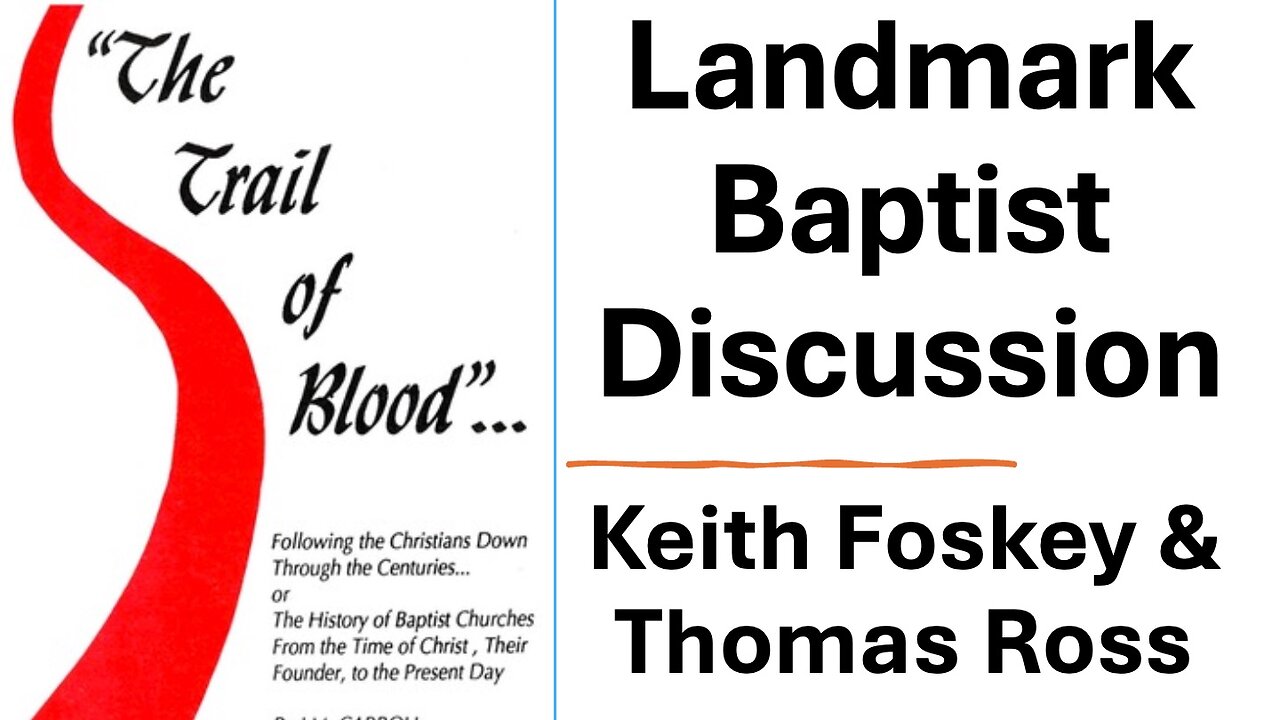Premium Only Content

Keith Foskey & Thomas Ross discussion (Bow Tie Dialogue): Landmark Baptist Succession / Perpetuity?
Does the Bible teach, and does history support, Baptist historical succession or perpetuity from the first century until today, what is often called Baptist succession, or the Landmark Baptist / Landmarkism theory, often itself associated with what is called the Baptist Bride theory, advocated in works such as J. M. Carroll's The Trail of Blood? Keith Foskey, minister at Sovereign Grace Family Church and host of the YourCalvinist podcast, discussed this question with Thomas Ross in a Bow Tie Dialogue.
Advocates of historic Baptist succession or perpetuity believe:
1.) The word "church" (Greek ekkelsia, Latinized as ecclesia) refers only to local, visible Christian congregations or assemblies. There is no universal or catholic church, whether a universal, visible church (as in Roman Catholicism) or a universal, invisible church (as in Magisterial Protestantism). Furthermore, Baptists reject the idea that outside the church there is no salvation. Not one of the 118 references to the word ekklesia in the New Testament, nor a single one of the references to ekklesia in the LXX, refer to something universal or invisible. Outside of the Greek Old Testament and Greek New Testament an ekklesia signified “an organized assembly of citizens, regularly summoned, as opposed to other meetings.” Christ and the Apostles spoke the Greek language of their day. Ekklesia was already in use in the first century. Nor is there any indication in Scripture that they gave the word a radical new meaning that it never had before—and to make a word that means "assembly" signify a group of people all over the world that never assemble would be a very radical change of meaning. When Christ promised to build up “His church” in Matthew 16:18, what was unique was not the word ekklesia or “church”—people were very familiar with what this word meant already, namely, a local, visible congregation. What was unique was the word “my.” This congregation or assembly belonged to Christ.
The church is compared in 1 Corinthians 12 to Christ’s body. Bodies are local and visible. 1 Timothy 3:15 compares the church to God’s house or temple. Temples are local and visible, not invisible; a bunch of bricks scattered all over the world is not a temple. 2 Corinthians 11:2 compares the church to Christ’s bride. Brides are local and visible. The church of Christ is local and visible, just like bodies, temples, and brides are local and visible.
The only universal "church" in the Bible is the Whore of Babylon, Roman Catholicism (Revelation 17).
The first reference after the New Testament to the church as the body of Christ appears in 1 Clement, written by Clement from the church in Rome to the church in Corinth. It employs the NT metaphor for the “body of Christ” just like Paul does in 1 Corinthians, of each congregation as local and visible (1 Clement 37-38).
Scripture teaches the perpetuity of Christ's church-His assembly of immersed disciples-from the first century until today:
“I will build my church; and the gates of hell shall not prevail against it” (Matthew 16:18b).
Go ye therefore, and teach [or “make disciples of”] all nations, baptizing them in the name of the Father, and of the Son, and of the Holy Ghost: Teaching them to observe all things whatsoever I have commanded you: and, lo, I am with you alway, even unto the end of the world. Amen. (Matthew 28:19-20)
In this passage, Christ addresses the church He started during His earthly ministry, before Pentecost. He tells His assembly to make disciples of all nations, immersing the disciples with the authority of the Triune God, and teaching them to obey everything He has commanded. He promised He would be with His immersionist assembly until the end of the world, promising a continuity of Trinitarian local congregations practicing believer’s immersion.
There are similar promises of church perpetuity in the epistles. For example, 1 Corinthians 11:26 promises:
For as often as ye eat this bread, and drink this cup, ye do shew the Lord’s death till he come. (1 Corinthians 11:26)
This passage teaches that there would be local congregations practicing the Lord’s Supper from the time Paul wrote to the Corinthians until Christ returns—which has not happened yet. These congregations would be practicing the Biblical ordinance of the Supper, not the Roman Catholic abomination of transubstantiation—they would be eating “bread,” not Christ’s human flesh, and drinking the fruit of the vine, not human blood, until Christ returns.
Paul also promises that God the Father would receive “glory in the church by Christ Jesus throughout all ages, world without end. Amen” (Ephesians 3:21).
So Scripture is clear that Christ would preserve local, visible congregations of disciples practicing the immersion of born-again disciples and a memorial view of the Lord’s Supper until the second coming of the Savior.
Christ's promise of Baptist succession is confirmed by both Catholic and Protestant historical records.
-
 25:31
25:31
MattMorseTV
16 hours ago $25.65 earned🔴We just got THE MOTIVE.🔴
48.4K178 -
 15:49
15:49
Nikko Ortiz
20 hours agoI Have A Gun
34.3K21 -
 15:51
15:51
GritsGG
17 hours agoWinning a Warzone Match From a Tree! #1 Player's POV!
24.6K2 -
 2:31:01
2:31:01
The Connect: With Johnny Mitchell
1 day ago $40.66 earned"It's About To Get Worse"- CIA Agent Andrew Bustamante Explains Why It's Time To Leave America
52.8K80 -
 16:21
16:21
The Pascal Show
1 day ago $3.84 earned'THE FEDS MADE THIS UP!' Candace Owens Drops BOMBSHELL Pushing Back On Details In Charlie Kirk Case
18.2K29 -
 LIVE
LIVE
Lofi Girl
2 years agoSynthwave Radio 🌌 - beats to chill/game to
282 watching -
 25:39
25:39
DeVory Darkins
15 hours ago $22.75 earnedMass shooting erupts in Michigan as bombshell study shows left wing political violence skyrocketed
66K136 -
 5:55:33
5:55:33
MattMorseTV
14 hours ago $134.92 earned🔴Portland ANTIFA vs. ICE.🔴
184K391 -
 3:13:00
3:13:00
Badlands Media
1 day agoThe Narrative Ep. 40: Acceleratia.
86.7K37 -
 6:57:01
6:57:01
SpartakusLIVE
13 hours ago#1 Solo Spartan Sunday || TOXIC Comms, TACTICAL Wins, ENDLESS Content
69.5K5